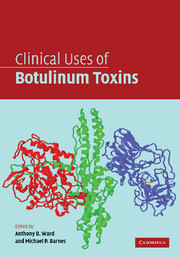Book contents
- Frontmatter
- Contents
- List of Contributors
- 1 Introduction
- 2 Mechanistic basis for the therapeutic effectiveness of botulinum toxin A on over-active cholinergic nerves
- 3 Botulinum toxin: from menace to medicine
- 4 Botulinum toxin: primary and secondary resistance
- 5 Introduction to botulinum toxin in clinical practice
- 6 Cervical dystonia
- 7 The use of botulinum toxin in otolaryngology
- 8 Spasticity
- 9 Hyperhidrosis
- 10 Hypersalivation
- 11 Botulinum toxin type A for the prophylactic treatment of primary headache disorders
- 12 Botulinum toxin in the management of back and neck pain
- 13 Clinical uses of botulinum toxin
- 14 Bladder and bowel indications
- 15 Cosmetic uses of botulinum toxin A
- 16 Other clinical neurological uses of botulinum toxin
- Index
- Plate section
- References
1 - Introduction
Published online by Cambridge University Press: 02 December 2009
- Frontmatter
- Contents
- List of Contributors
- 1 Introduction
- 2 Mechanistic basis for the therapeutic effectiveness of botulinum toxin A on over-active cholinergic nerves
- 3 Botulinum toxin: from menace to medicine
- 4 Botulinum toxin: primary and secondary resistance
- 5 Introduction to botulinum toxin in clinical practice
- 6 Cervical dystonia
- 7 The use of botulinum toxin in otolaryngology
- 8 Spasticity
- 9 Hyperhidrosis
- 10 Hypersalivation
- 11 Botulinum toxin type A for the prophylactic treatment of primary headache disorders
- 12 Botulinum toxin in the management of back and neck pain
- 13 Clinical uses of botulinum toxin
- 14 Bladder and bowel indications
- 15 Cosmetic uses of botulinum toxin A
- 16 Other clinical neurological uses of botulinum toxin
- Index
- Plate section
- References
Summary
Introduction
This book has been written to highlight the remarkable progress in the application of botulinum toxin in medical practice. It is used across many specialties and has an increasing indication across a whole spectrum of diseases. As a result, its commercial sales have grown exponentially and its use in cosmesis has made ‘BOTOX®’ a household name. This is extraordinary after such a short time in this field and some other products have even gone so far as to add an ‘-ox’ on the end of their brand name to attempt to capture some of the kudos (and market) of botulinum toxin. This is of course very different from when the drug was first marketed and when it was regarded as a highly dangerous product. The indications for botulinum toxin treatment are listed in Chapter 5. In many, there is still little or no evidence that it works, but in others, there is good evidence of its therapeutic benefit.
History of BoNT
Botulinum toxin was first identified as a poison in the nineteenth century. The toxin is a protein, which is produced by the Gram negative Clostridium botulinum bacterium. It is found in a variety of foods, but is most common in meat products. The name botulus means sausage and hence its terminology from its appearance in meat products. The features of botulism have been known since around the time of Christ and it was certainly described in the Middle Ages.
- Type
- Chapter
- Information
- Clinical Uses of Botulinum Toxins , pp. 1 - 8Publisher: Cambridge University PressPrint publication year: 2007

